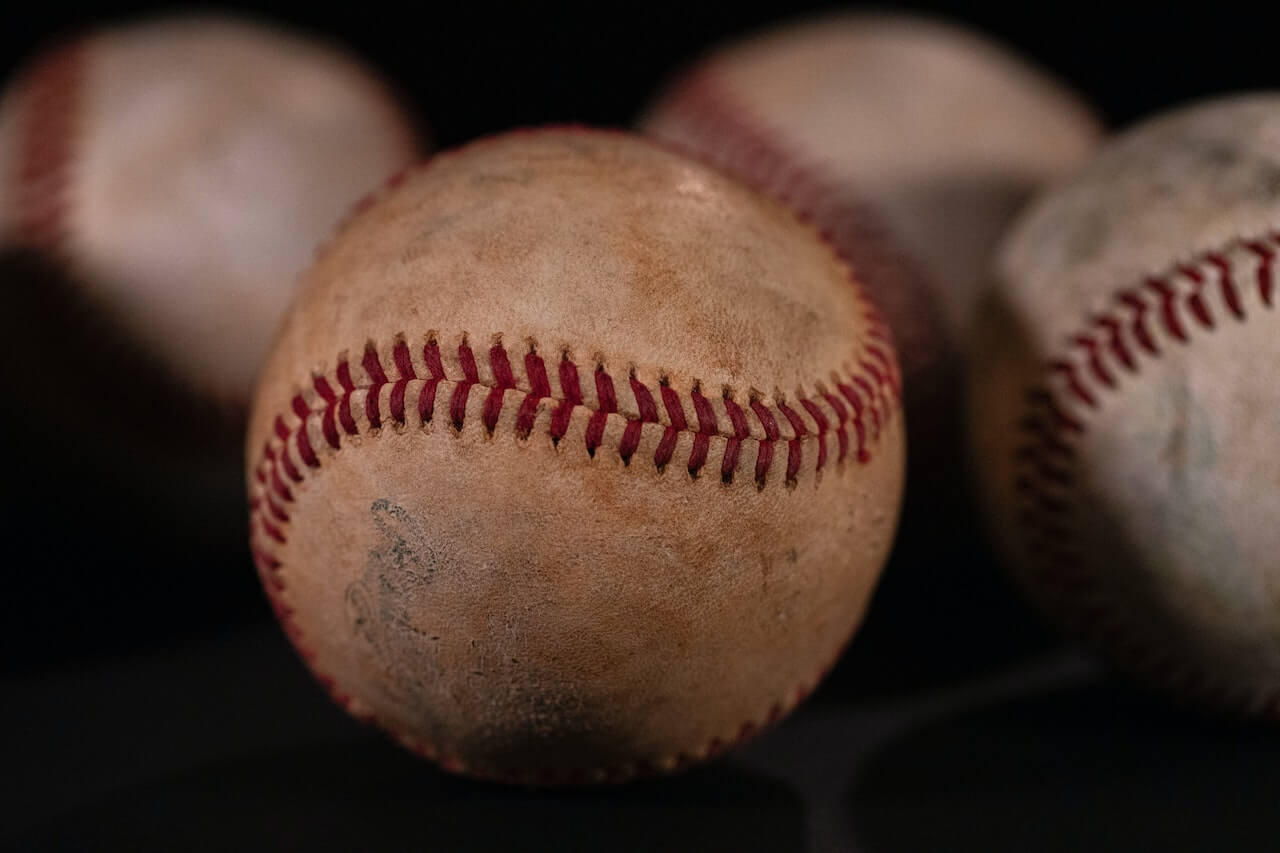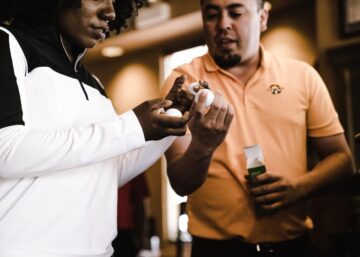Baseball is a sport that has been around for over a century, and it has remained relatively unchanged throughout that time. One of the most important components of a baseball is the stitching that runs along the surface of the ball. These stitches are what gives the ball its unique shape and help pitchers to throw curveballs, sliders, and other pitches with precision.
So, how many stitches are on a baseball? The answer is 108. Each baseball is hand-sewn with 108 stitches of waxed red cotton thread. These stitches are evenly spaced and form two perpendicular lines that run around the circumference of the ball. The stitching also creates an X pattern on the top of the ball, which helps pitchers to grip the ball more easily.
The stitching on a baseball is an essential part of the game. It not only gives the ball its unique shape but also helps pitchers to throw different types of pitches. The next time you watch a baseball game, take a closer look at the ball and appreciate the craftsmanship and attention to detail that goes into making each one.
The Anatomy of a Baseball
A baseball is a small, round ball used in the sport of baseball. It is made up of several different components, each with its own unique purpose. Understanding the anatomy of a baseball is important for players, coaches, and fans alike.
The outer layer of a baseball is made up of two pieces of leather, which are stitched together with red thread. The stitching on a baseball is one of its most recognizable features, and it serves an important purpose. There are exactly 108 stitches on a regulation baseball, and they are all hand-sewn. The stitching helps to keep the ball together and also affects the way it moves through the air.
Inside the leather cover of a baseball is a layer of yarn. The yarn is tightly wound around a small, cork center. The cork center is what gives a baseball its weight and helps it to maintain its shape. The yarn is also an important component of the ball’s structure, as it helps to absorb impact and prevent the ball from becoming deformed.
Overall, the anatomy of a baseball is a carefully crafted and well-designed system. Each component plays a crucial role in the ball’s performance, and any changes to the design could have a significant impact on the way the ball behaves during play.
The Stitching Process
When it comes to baseballs, the stitching process is a crucial step in creating a high-quality ball. The stitching process involves several steps, including creating the leather cover, adding inner layers, and finally stitching the ball together.
The Leather Cover
The first step in the stitching process is creating the leather cover. The cover is made from high-quality leather, which is carefully selected for its durability and strength. Once the leather has been selected, it is cut into the appropriate size and shape for the ball.
After the leather has been cut, it is then stretched over the inner layers of the ball. This process requires a great deal of skill and precision, as the leather must be stretched evenly and tightly over the ball to ensure a smooth, seamless finish.
The Inner Layers
Once the leather cover has been added to the ball, the inner layers are added. These layers provide the ball with its structure and help it maintain its shape during play.
The inner layers typically consist of a combination of wool, cork, and rubber. The wool is used to provide cushioning, while the cork and rubber are used to give the ball its shape and weight.
The Stitching Technique
The final step in the stitching process is the actual stitching of the ball. The stitching is done by hand, using a special needle and thread.
The stitching technique used is known as a “figure-eight” stitch. This involves looping the thread around the ball in a figure-eight pattern, which helps to keep the leather cover tight and secure.
Overall, the stitching process is a complex and precise process that requires a great deal of skill and expertise. By following these steps, manufacturers are able to create high-quality baseballs that are durable, reliable, and perfect for the game.
The Number of Stitches on a Baseball
A baseball is a small, round ball used in the sport of baseball, which is played by two teams of nine players each. The ball is made up of a cork or rubber center, wrapped in yarn, and covered in leather. One of the most distinctive features of a baseball is the number of stitches on its surface. The stitches are used to hold the leather covering together and to give the ball its characteristic appearance and texture.
Official Regulations
According to the official regulations of Major League Baseball (MLB), a baseball must have exactly 108 stitches. Each stitch must be 0.047 inches in length and must be made with waxed red cotton thread. The stitches must be evenly spaced and must form two perpendicular lines that divide the ball into four equal sections. The stitching must be tight and uniform, with no loose or dangling threads.
While the regulations for other baseball leagues may differ slightly, most leagues follow similar guidelines for the number and placement of stitches on a baseball.
Variations in Stitching
While most baseballs have 108 stitches, there are some variations in stitching that can affect the ball’s flight and trajectory. For example, some baseballs may have slightly raised or lowered stitching, which can cause the ball to curve or sink more than a standard ball. Other baseballs may have tighter or looser stitching, which can affect the ball’s spin and speed.
Some manufacturers also produce baseballs with different types of stitching, such as raised or flat seams, which can affect the ball’s movement through the air. These variations are often used in practice or training balls, rather than in official games.
Overall, the number of stitches on a baseball is an important factor in the game of baseball, affecting the ball’s appearance, texture, and flight. While most baseballs have 108 stitches, there are some variations in stitching that can affect the ball’s movement and trajectory.
The Importance of Stitching on a Baseball
Stitching on a baseball is one of the most important aspects of the game. Without proper stitching, the ball would not hold its shape or last as long during gameplay. The stitching on a baseball is what gives it its unique look and feel, and it is what allows pitchers to throw a variety of pitches.
Each baseball is made up of 108 stitches, which are hand-sewn onto the leather cover of the ball. The stitching is done in a specific pattern, which creates the raised seams that are a defining characteristic of a baseball. These seams allow the pitcher to grip the ball better, which helps them to throw a variety of pitches, such as a fastball, curveball, or slider.
While the stitching on a baseball may seem like a small detail, it can make all the difference in a game. A well-stitched ball can make it easier for a pitcher to throw strikes and for fielders to make accurate throws. It can also make it easier for batters to hit the ball, as they can see the rotation of the ball more clearly as it approaches the plate.
Overall, the stitching on a baseball is a crucial aspect of the game. It may seem like a small detail, but it can have a big impact on the outcome of a game. Whether you are a player or a fan, it is important to appreciate the craftsmanship and attention to detail that goes into making each and every baseball.
Conclusion
After conducting a thorough analysis of the stitches on a baseball, it is clear that there are exactly 108 stitches on each ball. This number has remained consistent throughout the history of the sport and is a crucial aspect of the game.
The stitches on a baseball not only provide an essential grip for pitchers to throw their pitches, but they also contribute to the unique and iconic appearance of the ball. Additionally, the number of stitches has an impact on the flight and trajectory of the ball, making it an important factor in the game of baseball.
Overall, the number of stitches on a baseball is a fascinating aspect of the sport that has remained unchanged for over a century. It is a testament to the enduring traditions and history of baseball, and a reminder of the importance of attention to detail in the game.







